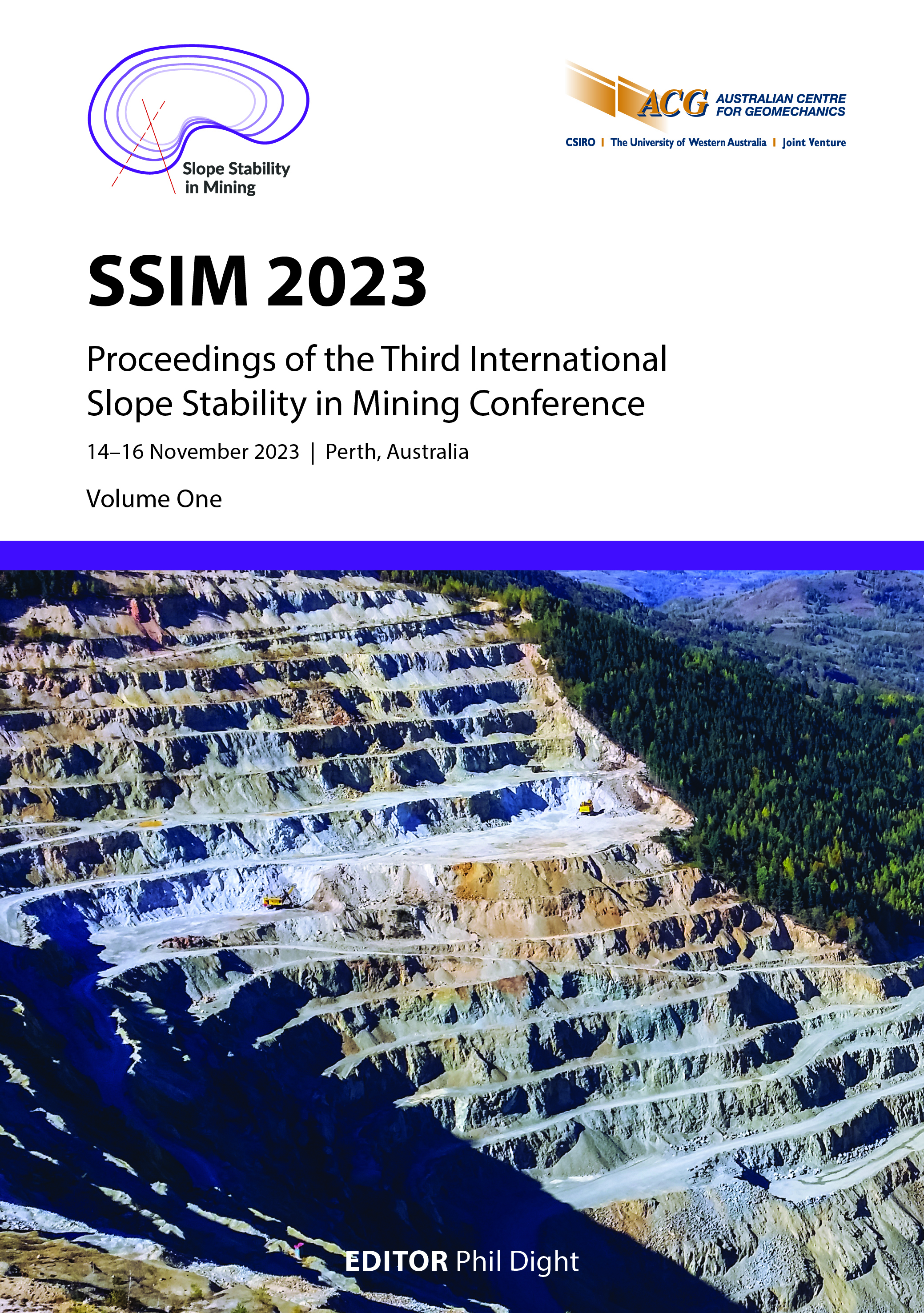Rockfalls as precursory strain indicators leading to a large slope failure (‘Leo Failure’) at Bingham Canyon Mine, USA

|
Authors: Schafer, KW; Bakken, KM; Ergun, S; Potter, J; Ross, BJ; Telfer, JA; Williams, CP |
DOI https://doi.org/10.36487/ACG_repo/2335_49
Cite As:
Schafer, KW, Bakken, KM, Ergun, S, Potter, J, Ross, BJ, Telfer, JA & Williams, CP 2023, 'Rockfalls as precursory strain indicators leading to a large slope failure (‘Leo Failure’) at Bingham Canyon Mine, USA', in PM Dight (ed.), SSIM 2023: Third International Slope Stability in Mining Conference, Australian Centre for Geomechanics, Perth, pp. 721-732, https://doi.org/10.36487/ACG_repo/2335_49
Abstract:
Rockfalls and rockslides are ubiquitous hazards at the Bingham Canyon Mine, where a large (19 × 106 tonnes) slope failure (‘Leo Failure’) occurred on 31 May 2021. The deforming slope was monitored with continuous thermal video recordings. This study documents (based upon thermal video review) both the frequency and spatial distribution of rockfalls leading to the slope failure. Thermal video monitoring began approximately four days prior to collapse, during the final acceleration phase. The frequency of rockfalls increases exponentially leading to failure, with approximately 45% of the total documented rockfalls (158) occurring within six hours of the failure. Of the documented rockfalls 88% are spatially coincident (within 15 m) with a left, the right, and crestal failure boundaries, but not the break-out at the toe. The majority of rockfalls (60%) repeatedly originate from nearly the same positions within three different areas (clusters): Cluster 1 positioned along the right-release, a bedding-parallel fault with clay-gouge; and both clusters 2 and 3 positioned along a multi-staged left-release, a complex intra-intrusive, fractured igneous contact. Approximately twice the number of rockfalls originate from each of both Cluster 2 (N = 44) and Cluster 3 (N=33) as compared to Cluster 1 (N=19). The cumulative rockfall versus time curve for Cluster 1, along the contiguous faulted-bedding right-release, generally exhibits a progressive acceleration up to the time of failure. In contrast, a cumulative rockfall curve for Cluster 2, along a geometrically complex leftrelease, exhibits a series of three abrupt periods of rapid rockfall accelerations (e.g. 1–1.5 per day to 70–75 per day). The cyclical accelerations and greater number of rockfalls are attributed to brittle strain localisation at geometric asperities associated with an evolving ‘step-path’ left-release, as opposed to creepstrain along an inherited, clay-rich sedimentary contact reactivated as a fault.
Keywords: rockfall, slope failure, slope stability in open pit mines
References:
Armitrano, D. Grasso, JR & Senfaute, G 2005, ‘Seismic precursory patterns before a cliff collapse and critical point phenomena’, Geophysical Research Letters, vol. 32.
Broadbent, C & Zavodni, Z 1982, ‘Influence of rock structures on stability, in stability in surface mining’, Society of Mining Engineers, vol. 3.
Byerlee, J 1978, ‘A review of rock mechanics studies in the United States pertinent to earthquake prediction’, PAGEOPH, vol. 116,
Fukuzonu, T 1985, ‘Inverse velocity over time a new method for predicting the failure time of a slope’, Proceedings of the IVth International Conference and Field Workshop on Landslides.
Hobbs, BE 1976, An Outline of Structural Geology, John Wiley & Sons, Hoboken.
Kemeny, J 1991, ‘A model for non-linear rock deformation under compression due to sub-critical crack growth’, International Journal of Rock Mechanics and Mining Sciences, vol. 28, no. 6, pp. 459–467.
Kromer, R, Hutchison, J, Lato, M & Gauthier, D 2015, ‘Identifying rock slope failure precursors using LiDAR for transportation corridor hazard management’, Engineering Geology , vol. 195.
Lockner, D & Byerlee, J 1992, ‘Fault growth and acoustic emissions in confined granite’, American Society of Mechanical Engineers Applied Mechanical Reviews, vol. 45, no. 3.
Lockner, D 1993, ‘Room temperature creep in saturated granite’, Journal of Geophysical Research: Solid Earth , vol. 98, no. B1, pp. 475–487.
Read, J & Stacey, P 2009, Guidelines for Open Pit Slope Design, CSIRO Publishing, Melbourne.
Rose, ND & Hungr, O 2006, ‘Forecasting potential slope failure in open pit mines – contingency planning and remediation’, International Journal of Rock Mechanics and Mining Sciences, vol. 44.
Rosser, N, Lim, M, Petley, D, Dunning, S & Allison, R 2007, ‘Patterns of precursory rockfall prior to slope failure’, Journal of Geophysical Research, vol. 112, F04014,
Shao, J, Duveau, G, Hoteit, N, Sibai, M. & Bart, M. 1997, ‘Time Dependent Continuous Damage Model for Deformation and Failure of Brittle Rock’, International Journal of Rock Mechanics and Mining Sciences, vol. 34, no. 3-4.
Senfaute, G, Duperret, A & Lawrence, J 2009, ‘Micro-seismic precursory cracks prior to rock-fall on coastal chalk cliffs: a case study at Mesnil-Val, Normandie, NW France’, Natural Hazards and Earth System Sciences, vol. 9, pp. 1625–1641.
Voight, BA 1988, ‘A method for prediction of volcanic eruptions’, Nature, no. 332, pp. 125–130.
Wellman, E, Schafer, K, Williams, C & Ross, B 2022, ‘Thermal imaging for rockfall detection’, paper presented at 56th U.S. Rock Mechanics/Geomechanics Symposium, Santa Fe,
Zavodni, Z 2001, ‘Time-dependent movements of open-pit slopes’, SME Proceedings, Society for Mining, Metallurgy & Exploration, Englewood, pp. 81–87.
© Copyright 2025, Australian Centre for Geomechanics (ACG), The University of Western Australia. All rights reserved.
View copyright/legal information
Please direct any queries or error reports to repository-acg@uwa.edu.au
View copyright/legal information
Please direct any queries or error reports to repository-acg@uwa.edu.au

